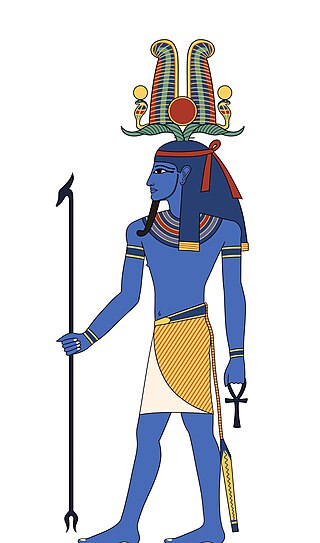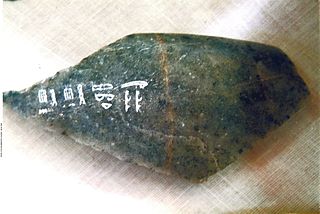
Memphis, or Men-nefer, was the ancient capital of Inebu-hedj, the first nome of Lower Egypt that was known as mḥw ("North"). Its ruins are located in the vicinity of the present-day village of Mit Rahina, in markaz (county) Badrashin, Giza, Egypt. This modern name is probably derived from the late Ancient Egyptian name for Memphis mjt-rhnt meaning "Road of the Ram-Headed Sphinxes".

Ptah is an ancient Egyptian deity, a creator god and patron deity of craftsmen and architects. In the triad of Memphis, he is the husband of Sekhmet and the father of Nefertem. He was also regarded as the father of the sage Imhotep.

Seker is a hawk or falcon god of the Memphite necropolis in the Ancient Egyptian religion, who was known as a patron of the living, as well as a god of the dead. He is also in some accounts a solar deity as for The Temple of Seker in Memphis.

In ancient Egyptian religion, Apis or Hapis, alternatively spelled Hapi-ankh, was a sacred bull or multiple sacred bulls worshiped in the Memphis region, identified as the son of Hathor, a primary deity in the pantheon of ancient Egypt. Initially, he was assigned a significant role in her worship, being sacrificed and reborn. Later, Apis also served as an intermediary between humans and other powerful deities.

Isetnofret was one of the Great Royal Wives of Pharaoh Ramesses II and was the mother of his successor, Merneptah. She was one of the most prominent of the royal wives, along with Nefertari, and was the chief queen after Nefertari's death.
Merit-Ptah was thought to be a female chief physician of the pharaoh's court during the Second Dynasty of Egypt, c. 2700 BCE; she is purportedly referred as such on an inscription left on her grave at Saqqara by her son.

The Shabaka Stone, sometimes Shabaqo, is a relic incised with an ancient Egyptian religious text, which dates from the Twenty-fifth Dynasty of Egypt. In later years, the stone was likely used as a millstone, which damaged the hieroglyphs. This damage is accompanied by other intentional defacements, leaving the hieroglyphic inscription in poor condition.
5011 Ptah is a near-Earth object and potentially hazardous asteroid of the Apollo group. It was discovered by astronomers with the Palomar–Leiden survey on 24 September 1960. The rare O-type asteroid on an eccentric orbit measures approximately 1.6 kilometers in diameter. It was named after the Ancient Egyptian deity Ptah.
Peseshet, who lived under the Fourth Dynasty of ancient Egypt, is often credited with being the earliest known female physician in history. Some have credited Merit-Ptah with being the first female physician, but she is likely a fictional creation based upon Peseshet. Peseshet’s relevant title was "lady overseer of the female physicians," but whether she was a physician herself is uncertain. She also had the titles king's acquaintance, and overseer of funerary-priests of the king's mother.

The Temple of Ptah is a shrine located within the large Precinct of Amun-Re at Karnak, in Luxor, Egypt. It lies to the north of the main Amun temple, just within the boundary wall. The building was erected by the Pharaoh Thutmose III on the site of an earlier Middle Kingdom temple. The edifice was later enlarged by the Ptolemaic Kingdom.

Ancient Egyptian creation myths are the ancient Egyptian accounts of the creation of the world. The Pyramid Texts, tomb wall decorations, and writings, dating back to the Old Kingdom have provided the majority of information regarding ancient Egyptian creation myths. These myths also form the earliest religious compilations in the world. The ancient Egyptians had many creator gods and associated legends. Thus, the world or more specifically Egypt was created in diverse ways according to different parts of ancient Egypt. Some versions of the myth indicate spitting, others masturbation, as the act of creation. The earliest god, Ra and/or Atum, emerged from a chaotic state of the world and gave rise to Shu (air) and Tefnut (moisture), from whose union came Geb (earth) and Nut (sky), who in turn created Osiris, Isis, Set, and Nephthys. An extension to this basic framework was the Osiris myth involving Osiris, his consort Isis, and their son Horus. The murder of Osiris by Set, and the resulting struggle for power, won by Horus, provided a powerful narrative linking the ancient Egyptian ideology of kingship with the creation of the cosmos.

Tatenen was the deity of the primordial mound in ancient Egyptian religion. His name means "risen land" or "exalted earth", as well as referring to the silt of the Nile. As a primeval chthonic deity, Tatenen was identified with creation. Both feminine and masculine, he was an androgynous protector of nature from the Memphis area, the ancient capital of the Inebu-hedj nome in Lower Egypt.

Hornedjitef was an ancient Egyptian priest in the Temple of Amun at Karnak during the reign of Ptolemy III. He is known from his elaborate coffins, mummy mask and mummy, dating from the Early Ptolemaic Period and excavated from Asasif, Thebes, Egypt, which are all held in the British Museum. These related objects were chosen as the first of the hundred objects selected by British Museum Director Neil MacGregor in the 2010 BBC Radio 4 series A History of the World in 100 Objects.

The High Priest of Ptah was sometimes referred to as "the Greatest of the Directors of Craftsmanship". This title refers to Ptah as the patron god of the craftsmen.
Didia was High Priest of Ptah during the reign of Ramesses II. Didia succeeded his father Pahemnetjer into the office of High Priest of Ptah.

Seheqenre Sankhptahi was a pharaoh of the late 13th Dynasty, possibly the fifty-fourth or fifty-fifth king of this dynasty. He most likely reigned for a short period over the Memphite region during the mid-17th century BC, some time between 1663 BC and 1649 BC.

Pehen-Ptah was an ancient Egyptian high official, sculptor and maker of vases during the 2nd Dynasty or early 3rd Dynasty. It is disputed as to who was the king reigning during Pehen-Ptah's time of officeship.
Sekhem-ankh-Ptah was an ancient Egyptian high official who lived during the Old Kingdom period. His main title was that of a vizier, making him the most important official at the royal court, second only to the king. Other important titles of Sekhem-ankh-Ptah were "Overseer of all royal works" and "Overseer of the scribes of the king's document".
Wahtye was a high-ranking priest and official who served under King Neferirkare Kakai during the Fifth Dynasty of Egypt. Based on his skull, he was probably 35-years-old when he died.
Ptah is a god in Egyptian mythology.













